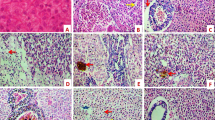Abstract
The effect of an acute increase in temperature, exhaustive exercise and hypoxia on the haematology of the benthic Antarctic teleost, Trematomus bernacchii was investigated. High temperature and hypoxia caused the biggest changes to the blood, with increases in haematocrit, haemoglobin concentrations and plasma chloride levels. The spleen decreased in mass. Exercise produced the smallest changes. Changes were substantially less than reported for the more active cryopelagic species Pagothenia borchgrevinki. The magnitude of the haematocrit increase is discussed in relation to life-style of fish living in the Antarctic.
Similar content being viewed by others
References
Axelsson M, Davison W, Forster ME, Farrell AP (1992) Cardiovascular responses of the red-blooded Antarctic fishes, Pagothenia bernacchii and P. borchgrevinki. J Exp Biol 167: 179–201
Barber DL, Mills Westermann JE, White MG (1981) The blood cells of the Antarctic icefish Chaenocephalus aceratus Lönnberg:light and electron microscopic observations. J Fish Biol 19:11–28
Davison W, Forster ME, Franklin CE, Taylor HH (1988) Recovery from exhausting exercise in an Antarctic Fish, Pagothenia borchgrevinki. Polar Biol 8:167–172
Egginton S, Taylor EW, Wilson RW, Johnston IA, Moon TW (1991) Stress response in the Antarctic teleosts (Notothenia neglecta Nybelin and N. rossii Richardson). J Fish Biol 38:225–236
Franklin CE, Davison W, Carey PW (1991) The stress response of an Antarctic teleost to an acute increase in temperature. J Therm Biol 16:173–177
Franklin CE, Davison W, McKenzie JC (1993) The role of the spleen during exhaustive exercise in the Antarctic teleost, Pagothenia borchgrevinki. J Exp Biol 174:381–386
Gallaugher P, Axelsson M, Farrell AP (1992) Swimming performance and haematological variables in spienectomized rainbow trout, Oncorhynchus mykiss. J Exp Biol 171:301–314
Hemmingsen EA, Douglas EL (1970) Respiratory characteristics of the hemoglobin-free fish, Chaenocephalus aceratus. Comp Biochem Physiol 33:733–744
Macdonald JA, Montgomery JC, Wells RMG (1987) Comparative physiology of Antarctic fishes. Adv Mar Biol 24:321–388
Montgomery JC, Wells RMG (1993) Recent advances in the ecophysiology of Antarctic notothenioid fishes:metabolic capacity and sensory performance. In:Rankin JC, Jensen FB (eds) Fish ecophysiology. Chapman & Hall, London, pp 341–374
Pankhurst NW, Wells RMG, Carragher JF (1992) Effects of stress on plasma cortisol levels and blood viscosity in blue maomao, Scorpis violaceus (Hutton), a marine teleost. Comp Biochem Physiol 101A:335–339
Wells RMG, Tetens V, DeVries AL (1984) Recovery from stress following capture and anaesthesia of antarctic fish:haematology and blood chemistry. J Fish Biol 25:567–576
Wells RMG, Grigg GC, Beard LA, Summers G (1989) Hypoxic responses in a fish from a stable environment:blood oxygen transport in the antarctic fish Pagothenia borchgrevinki. J Exp Biol 141:97–111
Wells RMG, Macdonald JA, diPrisco G (1990) Thin-blooded Antarctic fishes:a rheological comparison of the haemoglobin-free icefishes Chionodraco kathleenae and Cryodraco antarcticus with a red-blooded nototheniid, Pagothenia bernacchii. J Fish Biol 36:595–609
Wells RMG, Weber RE (1990) The spleen in hypoxic and exercised rainbow trout. J Exp Biol 150:461–466
Wells RMG, Weber RE (1991) Is there an optimal haematocrit for rainbow trout, Oncorhynchus mykiss (Walbaum)? An interpretation of recent data based on blood viscosity measurements. J Fish Biol 38:53–65
Winton MM (1974) Clinical haematology, 7th edn. Lea and Febiger, Philadelphia, 1896 pp
Yamamoto K, Itazawa Y, Kobayashi H (1980) Supply of erythrocytes into the circulating blood from the spleen of exercised fish. Comp Biochem Physiol 65A:5–11
Yamamoto K, Itazawa Y (1989) Erythrocyte supply from the spleen of exercised carp. Comp Biochem Physiol 92A:139–144
Author information
Authors and Affiliations
Rights and permissions
About this article
Cite this article
Davison, W., Franklin, C.E. & McKenzie, J.C. Haematological changes in an Antarctic teleost, Trematomus bernacchii, following stress. Polar Biol 14, 463–466 (1994). https://doi.org/10.1007/BF00239050
Received:
Accepted:
Issue Date:
DOI: https://doi.org/10.1007/BF00239050




